Zhang Xiaolong, Cheng Xin, Wang Yong
(Anhui Nari Zhongtian Power Electronics Co., Ltd., Hefei, Anhui 230031)
Abstract: To address the issues of slow data acquisition speed and poor functionality expansion in existing power data acquisition terminals, a design scheme for a power data acquisition terminal based on the SCM701 is proposed. This scheme uses the newly developed SCM701 processor as the management core, is based on an operating system platform, supports independent applications, and adopts a design philosophy of hardware modularization and software functionality as applications (APP). Extensive laboratory experiments and long-term field operations have shown that the acquisition terminal designed based on this scheme has significantly improved acquisition speed and data transmission stability, strong scalability, and can flexibly configure hardware functional modules and software applications (APP) according to user needs, greatly reducing on-site operation and maintenance costs. This represents a promising development direction for the next generation of power data acquisition terminals to meet future demands.
Keywords: acquisition terminal; operating system platform; application APP; modularization; functional scalability; SCM701
Classification Number: TP39; TN911
Article Number: 2095-1302 (2022) 08-0042-04
0 Introduction
According to the “Guiding Opinions on Promoting the Development of “Internet +” Smart Energy” jointly issued by the National Development and Reform Commission, the National Energy Administration, and the Ministry of Industry and Information Technology, combined with the current construction status of acquisition systems, acquisition systems will develop towards cloud computing, big data + metering, interactive clean energy, and shared reuse of acquisition systems. Therefore, power data acquisition terminals (hereinafter referred to as “acquisition terminals”) must meet the corresponding system development requirements and adapt to the development direction of “big cloud, internet, and mobility”. Existing acquisition terminal devices have a single structure, fixed functional configuration, and low resource allocation, making it difficult to meet the personalized installation and usage requirements of various acquisition sites, and acquisition terminal devices face the problem of upgrading and replacement.
1 Demand Analysis
By summarizing the current functional application status and application experience of acquisition terminals, analyzing the shortcomings in applications, the requirements for the next generation of acquisition terminals are as follows:
(1) Hardware functionality should be scalable: Design various application modules based on different application needs, with different specifications of modules connected via a unified interface, forming terminals that adapt to different business needs and achieve acquisition functionality;
(2) Unified management: Use a unified operating system as a platform to facilitate the management of the acquisition terminal’s file system and various application interfaces, achieving unified control;
(3) Business software should be upgradable: Fully utilize the characteristics of object-oriented abstraction, encapsulation, inheritance, and polymorphism to make the system easy to maintain, extend, and upgrade.
2 Hardware Design
In response to the above requirements, aimed at future applications and integrating mature new technologies from the industry, a new type of power information acquisition terminal is proposed with a design philosophy of “modularization and platformization”, including main control, encryption, clock, Bluetooth communication, power control, AC sampling, Ethernet, USB, buttons, LED indicators, and LCD display. The modules that support hot-swapping include HPLC module, 4G module, control module, 485 module, and backup module, where the backup module can be flexibly configured according to user needs to achieve personalized functionality. The hardware architecture is shown in Figure 1.
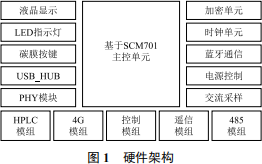
2.1 Main Control Unit
The main control unit is the “brain” of the acquisition terminal, responsible for logical operations, data analysis, storage, and control commands. The processor uses the domestic chip SCM701, which is a 4-core industrial-grade processor based on the ARM Cortex-A7 core, with a maximum frequency of 1.2 GHz. The peripheral interfaces support SATA2.0, 8-channel UART, and 4-channel SPI/I2C interfaces; the network interface supports access to WiFi/3G/4G networks, supports gigabit + hundred megabit dual network ports working simultaneously, and supports two USB2.0 Host and 1 OTG, with rich device interfaces that meet modular design requirements.2.2 Control ModuleThe control module receives control commands from the main control unit and performs on/off operations on external devices. The control unit uses a domestic 32-bit MCU, which is based on the ARM Cortex-M0 core, with strong computational processing capabilities and rich on-chip peripherals. The reliability requirements for the control module’s operation are very high. To ensure accurate on/off operations, the control unit conducts complete closed-loop detection for closing operations and uses logical methods combined with software algorithms to prevent misoperation caused by electromagnetic interference. Figure 2 shows the closed-loop detection circuit for the control module’s on/off operation.
2.3 4G Module
To ensure that the SIM card can communicate normally in cold regions, the 4G module adds a SIM card preheating circuit, which takes corresponding measures by reading the operating environment temperature. When the ambient temperature is below -20 °C, the SIM card preheating circuit is activated, and when the ambient temperature reaches above -20 °C, the heating circuit is turned off. This effectively ensures the stability of 4G communication for the acquisition terminal under extreme cold conditions. Figure 3 shows the SIM card preheating circuit of the 4G module, which uses transistor Q7 to complete the activation and deactivation of the heating circuit, achieving a simple method, low cost, and reliable performance.
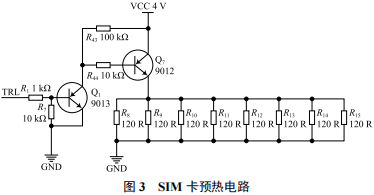
2.4 AC Sampling Circuit
The acquisition terminal is not a legal metering instrument, and its AC sampling data is not used for electricity billing. However, in practical applications, its sampling data is significant for line loss management in transformer stations and metering references, thus requiring high metering accuracy for the terminal. In this design scheme, the three-phase metering chip ATT7022E produced by Zhuhai Juchuan is used. This chip is a multifunctional anti-theft energy metering chip, integrating seven second-order sigma-delta ADCs, three of which are used for three-phase voltage sampling, three for three-phase current sampling, and one for zero line current or other anti-theft parameter sampling; it outputs sampling data and effective values. The chip’s characteristics, combined with suitable peripheral circuits, can achieve 0.5 level accuracy in energy metering, meeting practical application needs. In the design, to avoid measurement errors caused by the heating of the voltage sampling resistor network, the resistor network’s resistance packaging is selected as 1206, with large pads to facilitate heat dissipation, and the resistance value is calculated with sufficient margin, and during PCB layout, reasonable layout is performed to avoid excessive density that causes local heat accumulation, leading to resistance value drift.
AC sampling resistor network is shown in Figure 4.

3 Operating System and Firmware Design3.1 Operating System PortingOperating System Performance Indicators:(1) Average process creation time less than 1 ms;(2) Average process deletion time less than 1 ms;(3) Average time from power-on to login interface less than 1 min;(4) Average local pipe communication delay should be less than 80 ms;(5) Average semaphore delay should be less than 300 μs;(6) Average delay for continuous memory read/write should be less than 300 ns;(7) Average delay for random memory access should be less than 500 ns;(8) Average installation time for containers should be less than 30 s;(9) Average uninstallation time for containers should be less than 10 s;(10) Average installation time for application software should be less than 30 s.3.2 HAL Layer DesignTo reduce development complexity and porting difficulty, this design adopts a hierarchical design method, introducing the HAL layer (Hardware Abstraction Layer), which separates a layer that can directly communicate with hardware from the operating system, hiding the specific implementation details of different hardware devices and providing standardized hardware driver interfaces for various application software. It then provides abstract support for the upper layer, with the lower layer providing services to the upper layer in the form of APIs. When the upper layer performs hardware operations, it does not need to understand the specific details of the devices, and the hierarchical design greatly reduces the complexity of system understanding and development.Taking the LED module as an example, the HAL module code example and HAL interface call example are provided.HAL module partial code:
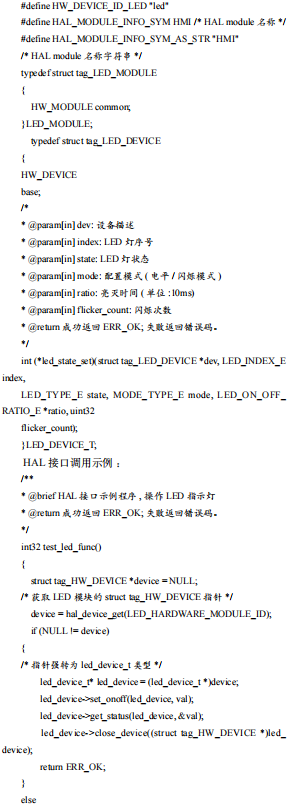

4 Application Design
The application is based on the embedded operating system, and the functional applications of the acquisition terminal are divided into basic APP, advanced business APP, and edge computing APP.
(1) Basic APP is the shared part of the advanced business APP, including system management, data center, wireless remote dial management, local meter reading module management, module manager, etc.;
(2) Advanced business APP, based on the basic APP combined with the business logic itself, includes residential energy management, large user energy management, orderly charging of electric vehicles, distributed energy management, enterprise energy efficiency management, intelligent monitoring of transformer stations, etc.;
(3) Edge computing APP, based on the business APP, is an extended application of the business APP.
5 Experimental Verification
To comprehensively verify the performance of this type of acquisition terminal, two phases of verification were conducted: laboratory verification and field trial verification, with field trial verification conducted after laboratory verification met the requirements. The results of the two-phase experiments indicate that this type of terminal fully meets the standard requirements in terms of functionality and performance, with some performance exceeding standard requirements.
5.1 Laboratory Verification
Based on national standards and State Grid enterprise standards, a total of over 40 various testing projects were conducted, covering electrical performance, electromagnetic compatibility, environmental impact, mechanical performance, and functionality. We present the results of power consumption tests and data transmission tests. Table 1 lists the power consumption experimental results, showing that the active power consumption of this type of acquisition terminal is equivalent to 1/4 of the technical requirements, far exceeding the standard technical requirements, which also aligns with China’s low-carbon development requirements.
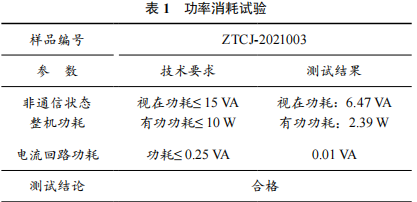
The performance indicators of the data transmission channel of this type of acquisition terminal are shown in Figure 5, indicating that this indicator is higher than the standard technical requirements, especially the ripple voltage in the terminal load capacity is far above the indicator requirements, which also indicates the high quality of the terminal’s power supply, providing strong assurance for the terminal’s future stable operation on-site.
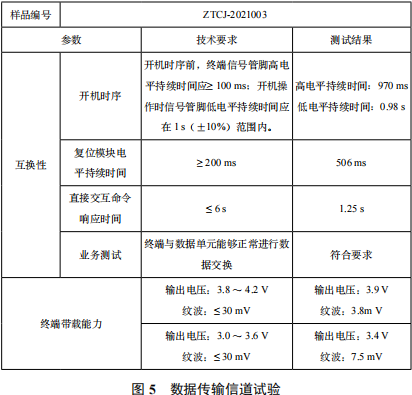
5.2 Field Trial
Five communities and ten transformer stations in ×× city were selected as pilot sites, and after three months of operation, the entire machine operated stably, with the product demonstrating good performance in communication speed and stability, indicating good promotional value.
6 Conclusion
The extensive verification results indicate that the acquisition terminal based on SCM701 adopts a design philosophy of software APP and hardware modularization, providing great flexibility, allowing it to adapt to different application scenarios. Users can flexibly choose hardware modules and install corresponding functionalities APP according to their needs, enhancing the product’s versatility. This type of acquisition terminal has shown significant improvements in performance indicators compared to previous terminals after long-term operation on-site, demonstrating good promotional value and providing a development direction for the evolution of power information acquisition devices, although further optimization of specific algorithm research is still needed.
References
[1] Lv Lianjie, Sun Xiaomei, Han Xu, et al. “The Current Status and Challenges of Smart Energy Development under the ‘Internet +’ Strategy” [C]// 2016 Power Industry Informatization Annual Conference, 2016.
[2] Ge Yanhua. Following the Rules of Intelligent Development—Joint Issuance of the “Guiding Opinions on Promoting the Development of ‘Internet +’ Smart Energy” [J]. China Electric Power, 2016, 67(6): 2.
[3] Editorial Department. Future Directions of Smart Energy [J]. China Energy, 2016, 38(4): 1.
[4] Wang Jinping. Research on the Construction of Power Marketing Electricity Information Acquisition Systems [J]. China Strategic Emerging Industries, 2017, 5(11X): 204-205.
[5] Training Center of State Grid Zhejiang Electric Power Company. Construction and Application of Intelligent Electricity Information Acquisition Systems [M]. Beijing: China Electric Power Press, 2013.
[6] Zhang Yuanwei, Yan Jun, Lei Jun, et al. Design of Data Acquisition Terminal for Warehouse Internet of Things [J]. Internet of Things Technology, 2014, 4(2): 32-33.
[7] Han Zhou, Meng Haichuan. Design of Intelligent Simulation Training Acquisition Terminal Based on Customer-side Ubiquitous Power IoT [J]. Internet of Things Technology, 2020, 10(5): 20-21.
[8] Dong Chaoyang, Zhao Junhua, Wen Fushuan, et al. From Smart Grid to Energy Internet: Basic Concepts and Research Framework [J]. Power System Automation, 2014, 38(15): 1-11.
[9] Qi Erjiang, Peng Daogang, Guan Xinlei, et al. Design of Remote Terminal Data Acquisition System for Intelligent Distribution Automation [J]. Electrical Drive, 2018, 48(7): 62-67.
[10] Hu Lefeng. Research and Implementation of Low-voltage Collection Technology for Intelligent Distribution Terminals [D]. Baoding: North China Electric Power University, 2017.
[11] Yao Feng, He Renjie, Tan Yuejin. Design and Implementation of Satellite Image Acquisition Task Scheduling System [J]. Aerospace Return and Remote Sensing, 2003, 24(3): 36-41.
[12] Liu Kun, Lu Bin, Liu Peng, et al. Design of Integrated Electricity Recharge Acquisition Terminal Based on Multi-task Scheduling [J]. Electrical Measurement and Instrumentation, 2012, 49(6): 77-80.
Author Information:
Zhang Xiaolong (1986—), male, from Huaibei, Anhui, engineer at Anhui Nari Zhongtian Power Electronics Co., Ltd., mainly engaged in embedded software development and research on power-related products.
Cheng Xin (1997—), male, from Suzhou, Anhui, assistant engineer at Anhui Nari Zhongtian Power Electronics Co., Ltd., mainly engaged in software development for power-related products.
Wang Yong (1976—), male, from Hefei, Anhui, engineer at Anhui Nari Zhongtian Power Electronics Co., Ltd., mainly engaged in operating system development.
About Us
The “Internet of Things Technology” journal elevates the concept of “Internet of Things” to a national development strategy, promoting it to the public in an easy-to-understand manner with examples. At the same time, we are committed to collecting and disseminating the latest global and national developments and trends in IoT technology; promoting new technologies, products, solutions, and application cases in the IoT industry, building an interactive platform for the development of the IoT industry, and promoting innovation, communication, and prosperity in IoT technology.
Approved by the National Press and Publication Administration as a professional technology journal on the Internet of Things
Included in the Chinese Core Journals (Selection) Database
Included in the China Academic Journal Network Publishing Database
Included in the Chinese Science and Technology Journal Database
Full-text included in Longyuan International Journal Network
This journal has been included in the “Domestic High-Quality Science and Technology Journal Grading Directory” T2 level
“RCCSE (Wuhan University Core) Chinese Academic Journal Ranking: Computer Technology B+”
Included in the China Academic Journal Network Publishing Database CNKI and the Chinese Science and Technology Journal Database
Included in the Chinese Core Journals (Selection) Database
Included in Longyuan Journal Network
Published in various national authoritative databases

Submission website: http://www.iotmag.com/

Scan to follow us
WeChat ID|iotmag
Customer Service Phone|029-85241792
All Things Connected
Intelligent Society

Share

Collect

Like

Looking